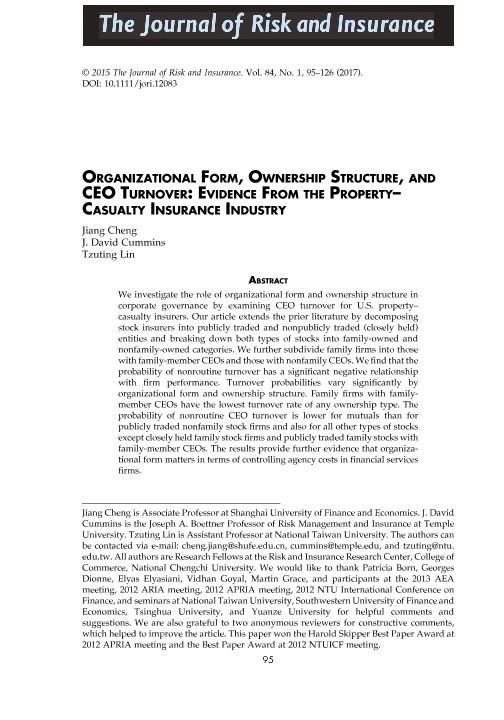Organizational form, ownership structure, and CEO turnover : evidence from the property-casualty insurance industry

Contenido multimedia no disponible por derechos de autor o por acceso restringido. Contacte con la institución para más información.
| Tag | 1 | 2 | Valor |
|---|---|---|---|
| LDR | 00000cab a2200000 4500 | ||
| 001 | MAP20170008651 | ||
| 003 | MAP | ||
| 005 | 20170405151623.0 | ||
| 008 | 170314e20170301esp|||p |0|||b|spa d | ||
| 040 | $aMAP$bspa$dMAP | ||
| 084 | $a2 | ||
| 100 | $0MAPA20100033623$aCheng, Jiang | ||
| 245 | 1 | 0 | $aOrganizational form, ownership structure, and CEO turnover$b: evidence from the property-casualty insurance industry$cJiang Cheng, ]. David Cummins, Tzuting Lin |
| 520 | $aWe investigate the role of organizational form and ownership structure in corporate governance by examining CEO turnover for U.S. property casualty insurers. Our article extends the prior literature by decomposing stock insurers into publicly traded and nonpublicly traded (closely held) entities and breaking down both types of stocks into family-owned and nonfamily-owned categories. We further subdivide family firms into those with family-member CEOs and those with nonfamily CEOs. We find that the probability of nonroutine turnover has a significant negative relationship with firm performance. Turnover probabilities vary significantly by organizational form and ownership structure. Family firms with familymember CEOs have the lowest turnover rate of any ownership type. The probability of nonroutine CEO turnover is lower for mutuals than for publicly traded nonfamily stock firms and also for all other types of stocks except closely held family stock firms and publicly traded family stocks with family-member CEOs. The results provide further evidence that organizational form matters in terms of controlling agency costs in financial services firms. | ||
| 650 | 4 | $0MAPA20080590567$aEmpresas de seguros | |
| 650 | 4 | $0MAPA20080586294$aMercado de seguros | |
| 773 | 0 | $wMAP20077000727$tThe Journal of risk and insurance$dNueva York : The American Risk and Insurance Association, 1964-$x0022-4367$g01/03/2017 Volumen 84 Número 1 - marzo 2017 , p. 95-126 |

